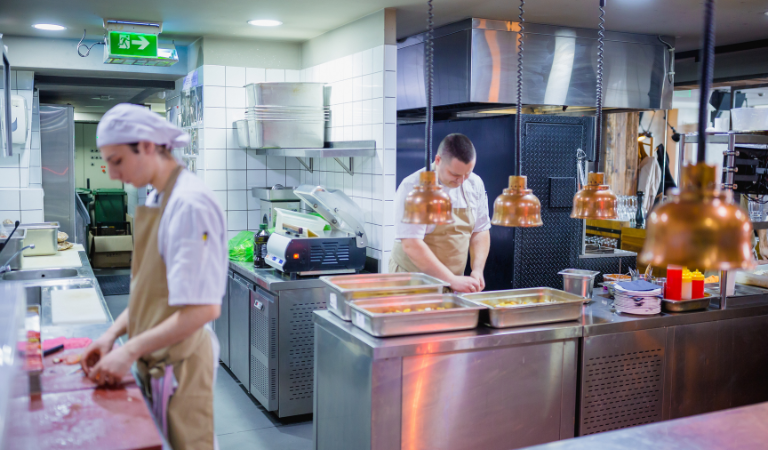In the ever-evolving world of food businesses, finding innovative and unique ways to reduce operating costs is key to maintaining profitability. While traditional cost-cutting strategies are effective, thinking outside the box and exploring unconventional methods that can yield significant savings is essential. In this article, we present ten game-changing approaches that can help food businesses cut expenses and boost their bottom line. From leveraging community partnerships to embracing alternative energy sources, these strategies will empower businesses to thrive in a competitive market while maximizing cost efficiency.

1. Forge Strategic Partnerships
Collaborating with local farmers, suppliers, and producers can be a game-changer for food businesses seeking to reduce costs. By forming strategic partnerships, businesses can access a consistent supply of high-quality ingredients at competitive prices. Additionally, consider teaming up with neighboring establishments for joint marketing campaigns or shared resources. These collaborations not only help cut procurement costs but also foster a sense of community and provide unique experiences for customers, setting your business apart from the competition.
2. Embrace Vertical Integration
Vertical integration involves owning and controlling different supply chain stages, from sourcing raw materials to delivering finished products. By vertically integrating certain processes, food businesses can streamline operations, reduce dependency on external suppliers, and eliminate unnecessary costs associated with middlemen. For example, a restaurant might consider growing its produce in an on-site garden or partnering with local farmers to ensure a steady supply of fresh ingredients. While vertical integration requires careful planning and investment, it can lead to long-term savings and enhanced quality control.
3. Implement Staff Incentive Programs
Motivated and engaged employees are invaluable assets for any food business. Implementing staff incentive programs can boost productivity, reduce turnover rates, and ultimately cut operational costs. Consider introducing performance-based bonuses, recognition schemes, or career development opportunities to incentivize employees to go the extra mile. When employees feel valued and rewarded for their efforts, they are more likely to exhibit loyalty and dedication. This, in turn, leads to increased efficiency, improved customer service, and reduced recruitment and training expenses.
4. Explore Alternative Energy Sources
Energy costs can significantly impact a food business's bottom line. Embracing alternative energy sources like solar power, wind turbines, or biomass systems can offer substantial long-term savings. While the upfront investment may seem daunting, the reduced reliance on traditional energy sources can lead to significant reductions in utility bills over time. Additionally, some regions offer tax incentives or grants for businesses transitioning to renewable energy. By going green, food businesses cut operating costs and demonstrate their commitment to sustainability, attracting eco-conscious customers.
5. Optimize Menu Engineering
Menu engineering involves strategically designing menus to maximize profitability and minimize waste. Analyze sales data to identify top-performing and high-margin items and highlight them through layout, descriptions, or pricing. Additionally, streamline ingredient usage by cross-utilizing ingredients across multiple dishes, reducing the need for excessive inventory. Monitor and adjust menu offerings regularly based on customer preferences and market trends. By optimizing menu engineering, food businesses can minimize food waste, optimize ingredient usage, and enhance profitability, all while providing a satisfying dining experience for customers.
6. Leverage Social Media Influencers
In today's digital age, social media influencers tremendously impact consumer behavior. Collaborating with influencers who align with your brand values can boost brand awareness and attract new customers at a fraction of the cost of traditional advertising. Consider offering free samples, exclusive promotions, or sponsored content in exchange for social media exposure. The reach and engagement generated by influencers can lead to increased foot traffic, online orders, and overall sales, ultimately reducing the need for extensive marketing campaigns and associated costs.
7. Optimize Packaging And Portion Sizes
Packaging and portion sizes play a significant role in a food business's operating costs. Explore eco-friendly packaging options that are cost-effective and align with your brand's sustainability goals. For instance, you can use sustainable cutlery, cups, and plates as part of your packaging. Additionally, measure portion sizes with serving ladles and utility scoops to ensure they are appropriate and minimize food waste. Offering smaller portions can cater to customers looking for lighter meals while reducing ingredient costs. By optimizing packaging and portion sizes, food businesses can reduce waste, enhance customer satisfaction, and lower expenses.

8. Embrace Data Analytics
Data analytics provides invaluable insights into consumer behavior, sales trends, and operational efficiency. Implement a robust analytics system to track key metrics such as inventory turnover, labor costs, and customer preferences. By leveraging data, food businesses can identify areas of inefficiency and make informed decisions to streamline operations. For example, data may reveal underperforming menu items that can be removed to reduce waste and overhead costs. By harnessing the power of data analytics, businesses can optimize processes, enhance profitability, and stay ahead of the competition.
9. Implement Remote Work And Automation
Incorporating remote work and automation can revolutionize how food businesses operate. Explore opportunities for employees to work remotely, reducing the need for physical office space and associated expenses. Automate repetitive tasks such as inventory management, payroll processing, and order taking through technology solutions. Automation not only minimizes human error but also frees up staff to focus on core business activities. By embracing remote work and automation, food businesses can significantly reduce overhead costs while improving efficiency and employee satisfaction.
10. Utilize Crowdsourcing And Shared Kitchens
Crowdsourcing and shared kitchens offer cost-effective alternatives for food businesses seeking to expand or test new concepts. Crowdsourcing platforms allow businesses to raise funds directly from their customer base, reducing reliance on loans or investors. Shared kitchens provide affordable access to commercial-grade equipment and facilities, eliminating the need for hefty investments in building and maintaining a dedicated kitchen space. These innovative approaches enable businesses to cut operating costs while nurturing creativity and fostering a sense of community among entrepreneurs.

Unlock Savings
In the ever-evolving food industry, thinking outside the box and exploring unconventional cost-cutting strategies can give food businesses a competitive edge. Businesses can significantly reduce operating costs while enhancing efficiency and profitability by forging strategic partnerships, embracing alternative energy sources, optimizing menu engineering, leveraging influencers, and embracing data analytics. Moreover, incorporating remote work, automation, and crowdsourcing can further revolutionize operations and unlock additional savings. By implementing these unique approaches, food businesses can thrive in a challenging market while keeping their bottom line healthy and sustainable.








